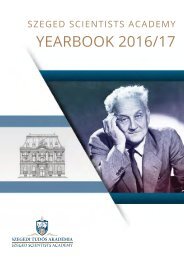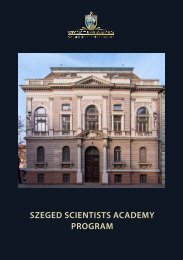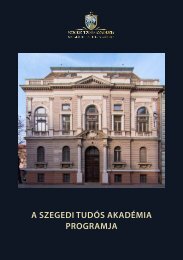Create successful ePaper yourself
Turn your PDF publications into a flip-book with our unique Google optimized e-Paper software.
SZENT-GYÖRGYI JUNIOR MENTORS<br />
SZABOLCS PÉTER TALLÓSY<br />
University of Szeged,<br />
Institute of Surgical Research<br />
Address: Pulz u. 1., H-6724 Szeged, Hungary<br />
RESEARCH AREA<br />
According to the criteria of “Sepsis-3” consensus conference,<br />
sepsis is defined as a life-threatening organ dysfunction<br />
caused by a dysregulated host response to infection.<br />
Sepsis is still one of the most frequent cause of death in<br />
intensive clinical care, so a well-standardized animal model<br />
compatible with human symptoms is essential in research.<br />
There are many descriptions of the process of sepsis in the<br />
related literature, but the microbiological background is a<br />
less researched area, despite the fact that sepsis is caused<br />
by a polymicrobial infection. Based on the above, only that<br />
sepsis model is appropriate, where live microorganisms<br />
are used, and for this reason, it is indispensable to describe<br />
the microbial profile of the animals, and calculate the<br />
initial concentration of the microorganism suspension for<br />
the sepsis induction. One of the major problems during<br />
sepsis is the disproportion between oxygen transport<br />
and use, which necessarily leads to the energy deficiency<br />
of the cells, therefore, we the mitochondrial effects of<br />
different pharmacons from the therapeutic targets were<br />
investigated. In our view, the main target of sepsis can be<br />
the supply of oxygen and energy to the body, mitigating<br />
the mitochondrial dysfunction, and thus reducing the<br />
inflammatory response to severe organ damage. We<br />
believe that our therapeutic approaches to mitochondrial<br />
dysfunction can improve the condition of septic patients.<br />
TECHNIQUES AVAILABLE IN THE LAB<br />
Our research laboratories are equipped with instruments<br />
to identify macro- and microcirculatory changes<br />
(hemodynamic computerized data-acquisition and<br />
analysis systems, laser-Doppler flowmetry, fluorescencebased<br />
intravital microscopy, orthogonal polarisation<br />
spectral imaging). Fluorescence confocal laser scanning<br />
endomicroscopy technique offers the possibility of<br />
acquiring precise in vivo data for histological analysis. A<br />
high resolution respirometer is available for examination<br />
of mitochondrial function (activities of the components<br />
of electron transport chain) and additional laboratory<br />
facilities (ELISA) to study inflammatory biomarkers. Animal<br />
house and fully-equipped operating theatres are available<br />
for surgical intervention of small (rats) and larger animals<br />
(minipigs).<br />
SELECTED PUBLICATIONS<br />
Tallósy, S.P. (2014) et al., Investigation of the antibacterial<br />
effects of silver-modified TiO2 and ZnO plasmonic<br />
photocatalysts embedded in polymer thin films. Environ.<br />
Sci. Pollut. Res. vol. 21, no. <strong>19</strong>, pp. 11155–11167, Oct. 2014.<br />
Tallósy, S.P. et al. (2016) Adhesion and inactivation of Gramnegative<br />
and Gram-positive bacteria on photoreactive<br />
TiO2/polymer and Ag–TiO2/polymer nanohybrid films.<br />
Appl. Surf. Sci., vol. 371, pp. 139–150, May 2016.<br />
Tallósy, S.P., Janovák, L., Ménesi, J., Nagy, E., Juhász, Á.,<br />
Dékány, I. (2014) LED-light Activated Antibacterial Surfaces<br />
Using Silver-modified TiO2 Embedded in Polymer Matrix. J.<br />
Adv. Oxid. Technol. vol. 17, no. 1, Jan. 2014.<br />
Janovak, L. et al. (2014) Synthesis of pH-sensitive copolymer<br />
thin solid films embedded with silver nanoparticles for<br />
controlled release and their fungicide properties. J. Drug<br />
Deliv. Sci. Technol. vol. 24, no. 6, pp. 628–636, Jan. 2014.<br />
Janovák, L. et al. (2017) Hydroxyapatite-enhanced<br />
structural, photocatalytic and antibacterial properties of<br />
photoreactive TiO2/HAp/polyacrylate hybrid thin films.<br />
Surf. Coatings Technol., vol. 326, pp. 316–326, Oct. 2017.<br />
Deák, Á. et al. (2015) Spherical LDH–Ag°-Montmorillonite<br />
Heterocoagulated System with a pH-Dependent Sol–Gel<br />
Structure for Controlled Accessibility of AgNPs Immobilized<br />
on the Clay Lamellae. Langmuir, vol. 31, no. 6, pp. 20<strong>19</strong>–<br />
2027, Feb. 2015.<br />
Samu, G.F. et al. (2017) Photocatalytic, photoelectrochemical,<br />
and antibacterial activity of benign-by-design<br />
mechanochemically synthesized metal oxide nanomaterials.<br />
Catal. Today, vol. 284, pp. 3–10, Apr. 2017.<br />
Veres, Á. et al. (2012) Journal of advanced oxidation<br />
technologies., vol. 15, no. 1. [STI, Science & Technology<br />
Integration], 2012.<br />
87












